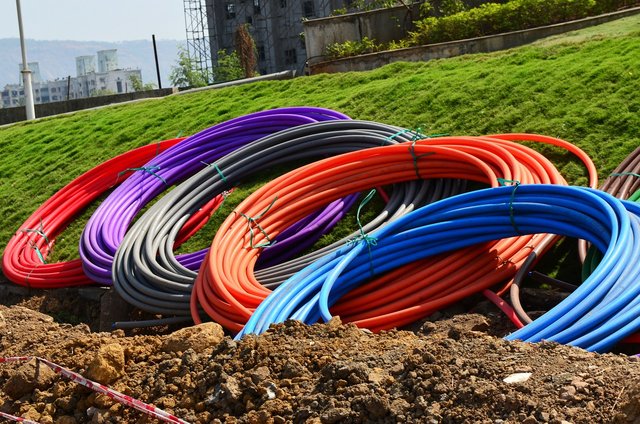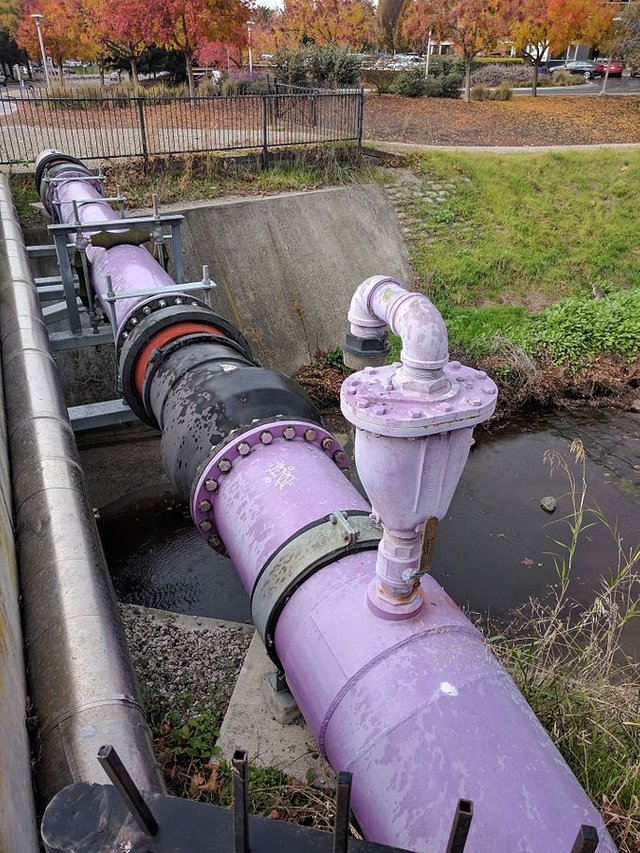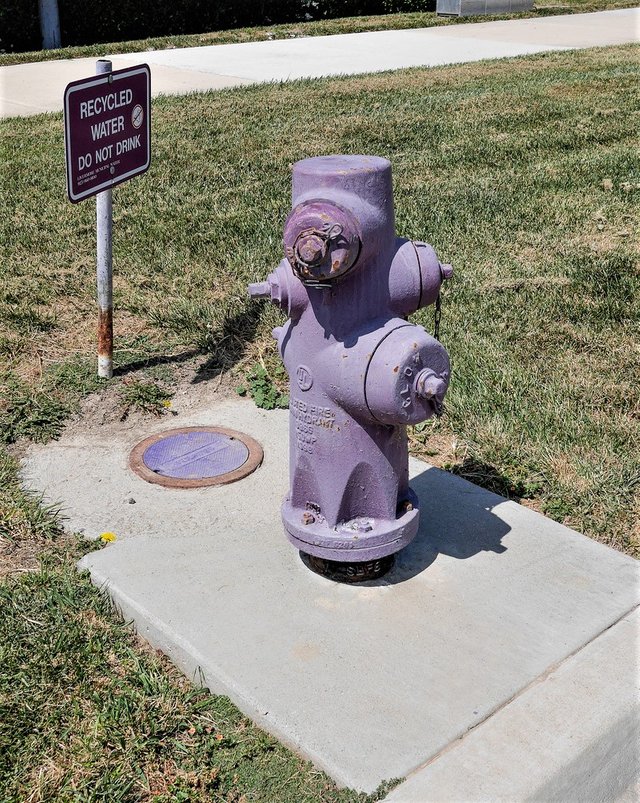
In dry regions of the United States, landscaping is a luxury. The lawns and gardens that one sees in wetter regions are not as common. Instead, dryscapes using rock and sand are often a better choice along with drought tolerant vegetation such as succulents and cacti.
But occasionally in dry places such as the southwestern United States, where water is scarce, you see a city that is more lush than you would have thought. That is more common in newer communities where housing developments have grown up in the last few years. In some such communities, you’ll notice that the parks, streets, and other common areas like community centers and schools look really green and well-watered, even while some of the private yards and not as well maintained.
What is going on here? It may have something to do with purple piping.

Source: Creative Commons via Wikimedia.com by Grendelkhan.
When most older cities were developed, they were done using the same water systems. But then came more population growth, droughts, and (in some areas) restrictions on water use. Every drop of water used on a park’s lawn is that much for people to drink or take showers in.
I have seen some where public fountains or ponds are normally a centerpiece of the community. Yet in drought years they may have to be drained and kept dry. Lawns at some parks and schools, also, have suffered cutbacks and often look more brown than green.
But as a backdrop, many cities and municipal areas have modern wastewater treatment facilities. That means that effluent (including sewage) can be treated to eliminate the sludge and impurities. Wastewater that is tertiary treated (that through three stages) is basically indistinguishable from any other drinking water. Let’s face it: every molecule of water in the world has been involved in some dirty activity sometime during its life on earth, even though it may have been cleaned up through being filtered naturally or evaporated in the millennia since.

Recycled water also is treated to a high level via filtration because most communities with this level of water treatment are reintroducing it back into the environment into a river, wetland, and aquifer, or other water source. A few areas even have permits to use it for agriculture, since the treated water is probably 99.9% the same as drinking water, and the .1% is only there because they are not able to warrant by law that it is completely pure.

Newer housing developments have the advantages of having newly-laid infrastructure, such as new pipes and electrical systems. In older areas, it costs a lot of money to tear up the streets and put in new pipes or cables. But these newer areas are able to incorporate more before they put in the new housing.
That’s where you often see purple piping.
In the world of pipes and conduit, there are different colors to make the function clear. As an article from Southern California Public Radio explained, cities in the U.S. generally use a common system for pipe coloring. Under that system, “blue is for potable water. Green is for sewers. Yellow signifies natural gas, oil, petroleum, or something else that’s potentially flammable. Orange is for telecommunications. Red is for power lines. And white is for marking where excavations and new pipe routes will go.” https://www.scpr.org/blogs/environment/2014/03/10/16035/purple-pipe-means-recycled-water-why-purple/

Purple was not being used, and so cities who incorporated recycled water into their projects began using it for that purpose. “Recycled water” a.k.a. (finely treated wastewater) can be used to irrigate many public areas. That’s why in some of these places, you will see really green spaces with lush lawns even during droughts and water restrictions. And if you look at little more closely, you also will notice that purple piping. In hot weather areas, the purple color tends to break down somewhat, often looking more pink than purple, or even a dull grey with just a hint of purple remaining.
So when you see pipes, sprinklers, drip systems, and plumbing boxes that are purple, that’s supposed to mean clean, recycled water used for irrigation. You’re not supposed to drink it. But dogs seem to think it’s pretty good for drinking also.

Source: Creative Commons via Flickr.com by Jay Galvin.
Images are public domain, by the author, or credited separately in the text.
@donkeypong, Very interesting title about some part of nature. There are more developed countries built up colorful piping system.
I'm living third class developing country. So my country used only same color piping for water system. But I heard before different kind of coloring pipes used for different meanings as you mentioned above. With technical development more countries like USA use identify piping system. It's very easy way to use deserve water part to humans.
Downvoting a post can decrease pending rewards and make it less visible. Common reasons:
Submit
Oh yes @donkeypong, I used to notice that the fire hydrants are painted red, but for the first time, purple will see on your photos and that you are now dividing pipes by color, I only learned from you. In my opinion it is very convenient from an economic point of view and it becomes clear for people what kind of water to use!
Downvoting a post can decrease pending rewards and make it less visible. Common reasons:
Submit
Excellent review, my friend, and you told me very interesting facts about water in your country. I had not even thought about the color of the pipes before, but now I clearly see that this was done specifically to denote water and I think it is convenient! Thanks @donkeypong
Downvoting a post can decrease pending rewards and make it less visible. Common reasons:
Submit
To be honest, I never thought that a certain color on pipes for water has any meaning, since in my country they are almost the same color and I have to notice that you have thought up this very correctly and this can be decisive in certain situations!
Downvoting a post can decrease pending rewards and make it less visible. Common reasons:
Submit
This is the US system, but it may not be the same in other places. It does require some advanced planning, which is why it isn't in use in older locations that didn't have as much of a water problem when they were built.
Downvoting a post can decrease pending rewards and make it less visible. Common reasons:
Submit
I helped install dual water supplies (the big stuff down the middle of the streets) more than two decades ago. And even though the town is filled with very well to do people, they have never built the recycled water tank on the pad we built for it.
Such a waste.
It puts me on the side of the people that believe that the water scarcity publicized so much is just to privatize water and charge people 10x for what they are getting now.
Downvoting a post can decrease pending rewards and make it less visible. Common reasons:
Submit
That's a good point. Could be.
Downvoting a post can decrease pending rewards and make it less visible. Common reasons:
Submit
I didn't know that. I'm going to keep a look out for purple fire hydrants. The purple pipes are probably harder to see since they're buried. That's a great idea for getting more usable water!
Downvoting a post can decrease pending rewards and make it less visible. Common reasons:
Submit
It's either that or put it back into nature. Nothing wrong with the latter, either, but more efficient to just use it somehow.
Downvoting a post can decrease pending rewards and make it less visible. Common reasons:
Submit
Hello friend many days without knowing you, I hope everything is fine, this information is great, Venezuela is a country where water is scarce, I have never seen a purple pipe, but irrigation systems, there are places where they no longer work but where they have water regularly is the green grass, do they receive the gas by pipeline too? I would like that in my town to happen like that, I always learn from your publications I will never forget that a purple pipe is clean water
Downvoting a post can decrease pending rewards and make it less visible. Common reasons:
Submit
Venezuela is certainly having a difficult time right now. Hope everything is well with you.
Downvoting a post can decrease pending rewards and make it less visible. Common reasons:
Submit
Yes, we are going through a very hard time, months ago at least we could buy food, today prices are very high, there is no edible gas, to buy it you have to make long lines for hours, there is a light of hope, we are waiting for you the best happens.
Downvoting a post can decrease pending rewards and make it less visible. Common reasons:
Submit
At least they have a system that works for them and each pipe can be identified, I had not heard about these purple pipes before. In my country everything is chaotic, there is no identification of pipes and very little is done to purify the water, although we have many wells, lakes and so many places where the water can come out they usually do rationing and it is because they do not give due maintenance to the pipes
Downvoting a post can decrease pending rewards and make it less visible. Common reasons:
Submit
It's difficult to maintain pipes because ion some places, they do on for long distances underground and under buildings and streets. Even in older cities here, there are lots of broken pipes on a regular basis.
Downvoting a post can decrease pending rewards and make it less visible. Common reasons:
Submit
It is a very interesting story and now I understand that you have a right to add a certain color for water of different purposes, which of course helps people in choosing water for certain purposes. It's great!
Downvoting a post can decrease pending rewards and make it less visible. Common reasons:
Submit
It's very lucky that you live in a modern country where the irrigation system is neatly arranged. The type of pipe determines its use. In my country there is no such system for using pipes. But the advantage is that we have very many water sources and are still very pure. so we don't need pipes because we will dig wells where the water is abundant.
Downvoting a post can decrease pending rewards and make it less visible. Common reasons:
Submit
You have enough water, which is fortunate!
Downvoting a post can decrease pending rewards and make it less visible. Common reasons:
Submit
It's interesting they painted it in different colors for different use. Something they don't do here in europe, or I didn't notice but certainly no purple color lol. Hope one day they come up with a good water system for some African countries as well.
Downvoting a post can decrease pending rewards and make it less visible. Common reasons:
Submit
Water is currently a major problem in my town and we only get water from public taps or boreholes which are the only source of private water.
Irrigation isn't practice in my town but in the northern part of the country (Cameroon)
I am happy to gotten an in sight about what the different colors of pipes represent in the US. Here;
We use black and blue for water pipes
Red for power lines too
brown, orange and more for telecommunications.
Rather to the color of water pipes breaking, the heads (Iron) attached to the pipes are always very rusty and no one cares about this factor. They are only changed when they get destroyed.
I have never seen a purple pipe been used for water (maybe it happens it areas where irrigation is practiced). So, I can say I have never drank water from such a pipe.
Anyways, thanks for the heads up!
Posted using Partiko Android
Downvoting a post can decrease pending rewards and make it less visible. Common reasons:
Submit
Recycling water is definitely a smart idea and efficient. I was not aware to the color coding of utility pipes but it makes complete sense. Thanks for sharing
Downvoting a post can decrease pending rewards and make it less visible. Common reasons:
Submit
Stuff I didn't know, and am glad I learned.
Thanks!
Downvoting a post can decrease pending rewards and make it less visible. Common reasons:
Submit
Is it water recycle safe for our consumption?
Or it just for watering the agriculture land?
Downvoting a post can decrease pending rewards and make it less visible. Common reasons:
Submit